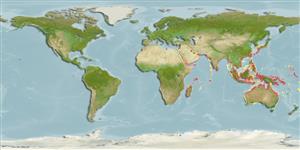Common names from other countries
>
Anguilliformes (Eels and morays) >
Ophichthidae (Snake eels) > Ophichthinae
Etymology: Pisodonophis: Greek, piso, pipisko = to drink + Greek, odous = teeth + Greek, ophis = serpent .
More on author: Hamilton.
Environment: milieu / climate zone / depth range / distribution range
पारिस्थितिकी
समुद्री; स्वच्छ जल, अलवण जल; खारा ड़िमरसल; ऐनाढरोमस (Ref. 51243); गहराई सीमा ? - 10 m (Ref. 86942). Tropical
Indo-West Pacific: Somalia (Ref. 30573) and Tanzania south to Knysna, South Africa (Ref. 3972), including the Seychelles (Ref. 7245); also southern India and Sri Lanka (Ref. 7245). Widespread elsewhere from the east Indian coast throughout Indonesia to Polynesia (Ref. 7245).
आकार / वज़न / Age
Maturity: Lm ? range ? - ? cm
Max length : 100.0 cm TL पुल्लिंग / अलिंग; (Ref. 3972); common length : 70.0 cm TL पुल्लिंग / अलिंग; (Ref. 7245)
पृष्ठीय रीढ़ (सम्पूर्ण): 0; गुदा कांटा 0; जानवरों की रीड़ का जोड़: 171 - 180. Diagnosis: Body snake-like, cylindrical, compressed only along extreme tail tip; anterior nostril tubular, posterior along lower edge of lip; teeth granular to molariform, multiserial bands on jaws and vomer, but sharper on jaws and more pointed in young individuals; median fins not continuous posteriorly; extreme tip of tail stiff and finless; dorsal fin origin about a pectoral fin length behind tips of pectoral fins; lateral line inconspicuous (Ref. 4832).
Found in lagoons and estuaries, entering freshwater and paddy fields (Ref. 7245, 30573). Common in tidal reaches and nearby upstream areas of coastal rivers (Ref. 12693). Lives in holes in the river bottom and bank and actively forages for small fishes at night (Ref. 12693). Reported to spawn in rice-paddies during the rainy season (Ref. 12693). Caught in bag nets and similar gear. Marketed fresh.
Life cycle and mating behavior
परिपक्व अवधि | पुनरुत्पत्ति | मछलीऔ का अंडे देना | अंडे | Fecundity | लार्वा
Castle, P.H.J., 1984. Ophichthidae. p. 38-39. In J. Daget, J.-P. Gosse and D.F.E. Thys van den Audenaerde (eds.) Check-list of the freshwater fishes of Africa (CLOFFA). ORSTOM, Paris and MRAC, Tervuren. Vol. 1. (Ref. 3508)
IUCN Red List Status (Ref. 130435)
CITES (Ref. 128078)
Not Evaluated
Threat to humans
Harmless
Human uses
मात्स्यिकी: लघु वाणिज्य; ठहराव / प्रलोभन: usually
अधिक जानकारी
आम नामउपशब्दचपायचयपरभक्षीईकोटोकसीकोलौजीपुनरुत्पत्तिपरिपक्व अवधिमछलीऔ का अंडे देनाFecundityअंडेEgg development
संदर्भजलीयकृषिजलीयकृषि रूपरेखाखींचआनुवंशिकीElectrophoresesहैरेटिबिलटीबीमारीप्रक्रमणMass conversion
साधन
Special reports
Download XML
इंटरनेट स्रोत
Estimates based on models
Preferred temperature (Ref.
115969): 24.6 - 29.2, mean 28.5 (based on 2626 cells).
Phylogenetic diversity index (Ref.
82804): PD
50 = 0.5020 [Uniqueness, from 0.5 = low to 2.0 = high].
Bayesian length-weight: a=0.00093 (0.00047 - 0.00184), b=2.97 (2.80 - 3.14), in cm Total Length, based on LWR estimates for this species & (Sub)family-body (Ref.
93245).
Trophic level (Ref.
69278): 4.0 ±0.71 se; based on food items.
लौटाव (Ref.
120179): माध्यम, न्यूनतम जनसंख्या दुगनी होने का समय 1.4 - 4.4 वर्ष। (Preliminary K or Fecundity.).
Fishing Vulnerability (Ref.
59153): High vulnerability (60 of 100).
